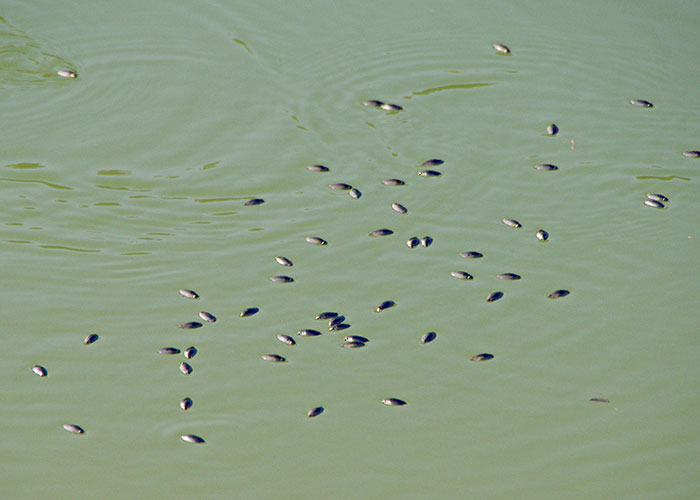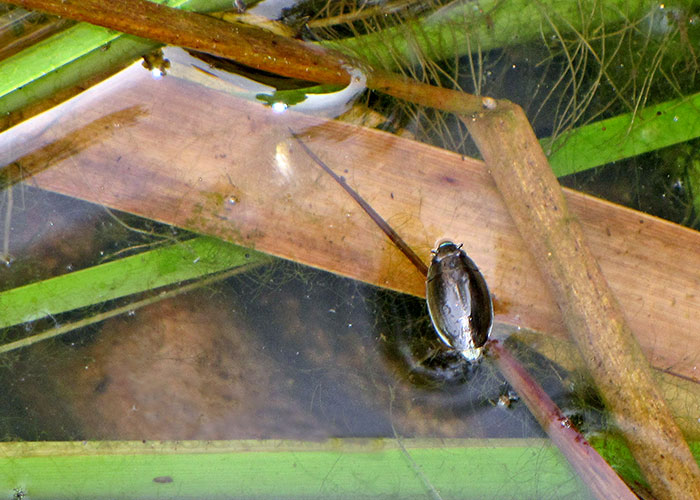Howdy, BugFans,
Whirligig beetles are referred to in Kaufman and Eaton’s Field Guide to Insects of North America as the “bumper cars of the beetle world.” Looking like dark watermelon seeds, mobs of whirligig beetles scoot across the still waters of ponds, lakes, streams and rivers. A very large “school” may contain as many as a dozen different species of whirligigs.
Whirligigs
Whirligigs are in the order Coleoptera (beetles) and in the family Gyrinidae (which has its roots in the Greek gyr meaning ring, circle, or spiral). Most are in either the ½” long Genus Dineutes or the ¼” long Gyrinus. “Sister cars,” their basic design is similar, with short antennae, elytra (hard wing covers) that end before the abdomen does, the ability to secrete a smelly substance that deters predators, and a shiny, black finish. Whirligig beetles’ eyes are split; half of each eye lies below the horizon and half rises above it, so they can view two worlds at once—pretty handy for a predator. When on the surface, they absorb air from the atmosphere, but they tuck an air bubble under their wings when they dive. They row with their flattened and fringed middle and hind pairs of legs, and they hold their front pair of legs forward, ready to grasp their prey. Impressive on the water’s surface, they are good swimmers underwater (they may dive when alarmed), and they migrate from pond to pond by flying.
For an insect-size animal, the top layer of water molecules has a tough film. Whirligigs and water striders skate on top of it; snails and leeches glide belly up on its under-surface. Other insects get stuck on it when they fly too close. For some below the surface, it can be a prison that they aren’t strong enough to break through. Whirligig beetles find their food stuck in that film. The last two segments of their antennae are used to detect the tiny waves made by insects struggling on the surface film, and they also scavenge on floating dead material. In A Guide to Common Freshwater Invertebrates of North America, Voshell surmises that “the waves that the adult whirligig beetles generate when swimming may function for the echolocation of food, like sonar used by ships at sea.” Wowsers!
Ms. Whirligig lays her eggs underwater, on plants. Like their parents, the immatures are “engulfer-predators. Climbers/swimmers, the larvae eat water mites, snails, worms, and other small aquatic insects (especially mosquitoes), and their brethren. They pick up dissolved oxygen from the water by means of external gills located on the sides of their abdomens. When the larvae are ready to pupate, they build a case of mud, sand, or leaf pieces on a damp shoreline. Dineutes adds to the degree of difficulty by doing this upside down, suspended over its building material from vegetation by its posterior hooks (think Houdini in a strait-jacket), stretching down to grab one mouthful at a time to construct a pupal case (NO, the BugLady is NOT making this up!).
Two other interesting whirligig-facts. Ann Haven Morgan reports in Field Book of Ponds and Streams that a researcher who fed freshly-killed larvae to captive adult Dineutes observed a piranha-like feeding frenzy. “As many as could would seize the insect, crowd around it, grasping it, whirling around it in wild curves and sometimes diving beneath the surface, but always holding on to their prey and tearing out mouthfuls of insect tissue.” The charming (second) fact that males can squeak isn’t quite enough to banish that mental picture.
Apparently, one of the things that alarms them is cameras, and this is another species that has defied the BugLady’s attempts to get an in-focus photograph. On the other hand, since Voshell says that they’ve been clocked at speeds up to 1 meter per second, the BugLady doesn’t feel so bad.
The BugLady

